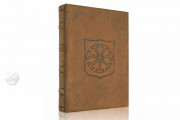The Treatise on the Apocalypse (Real Biblioteca del Monasterio de San Lorenzo de El Escorial, 1594) preserves a posthumous, bilingual Latin–Spanish rendering of Nostradamus’s Les Prophéties. Nearly a thousand pages long and accompanied by a substantial program of illustrations and tables, the volume embodies the late-Renaissance fascination with astrology, eschatology, and the language of signs. Produced within the intellectual orbit of the Escorial, it presents prophecy as a disciplined mode of reading history, heaven, and scripture together. Today it stands as one of the most ambitious prophetic artefacts in the royal library’s early modern holdings.
Prophecy and Knowledge in Late Sixteenth-Century Spain
Created in 1594, the Treatise reflects a Counter-Reformation culture that sought to reconcile scientific cosmology with Christian eschatology. Philip II’s Escorial aimed to assemble all forms of sacred and learned knowledge; placing a Nostradamus corpus in that matrix underscored prophecy’s status as an interpretive discipline rather than superstition. The manuscript’s deliberate bilingual Latin–Spanish format signals its intended reach across audiences—Latin for scholastic commentary, Spanish for a wider cultivated readership—anchoring prophetic exegesis within the Escorial’s scholarly network.
Translation, Interpretation, and the Theology of Time
Following the architecture of Les Prophéties, the text organises cryptic quatrains into “centuries” that intertwine astrological symbolism, biblical typology, and moral allegory. In this witness, prophecy functions less as prediction than as hermeneutics: a way of discerning correspondences between celestial events and human history within divine providence. The translation traditionally attributed to Amadeo Taboada Cid aligns with humanist aims—bringing a polyglot, allusive French original into a Latin–Spanish register that could stabilise meaning and authorise commentary within a learned Christian frame.
Vision, Diagram, and Apocalyptic Allegory
The accompanying cycle of fifty-four illustrations and tables interprets key motifs from the quatrains: planetary conjunctions and eclipses; comets and prodigies; allegories of kingship, conflict, judgment, and renewal. Stylistically, geometric and astronomical schemata coexist with visionary scenes, yielding a hybrid visual language in which diagram clarifies and image amplifies. The sequence reads as a visual commentary—translating verbal opacity into legible forms—thereby modelling how prophetic knowledge should be seen as well as read.
From Superstition to Intellectual Heritage
Within the Escorial, the 1594 Treatise crystallises an encyclopaedic ambition: to bind revelation, astronomy, and history into a single archive. Its later nineteenth-century cataloguing within the Real Biblioteca marks the modern reclassification of prophecy—from marginal curiosity to a component of Europe’s intellectual memory. For historians of science and art alike, the volume documents a moment when apocalyptic imagination and scholarly method converged, and when translating prophecy into Latin–Spanish was itself an act of knowledge-making.
We have 1 facsimile edition of the manuscript "Prophecies of Nostradamus 1594": Las Profecías de Nostradamus facsimile edition, published by Ediciones Boreal, 2003
Request Info / Price

